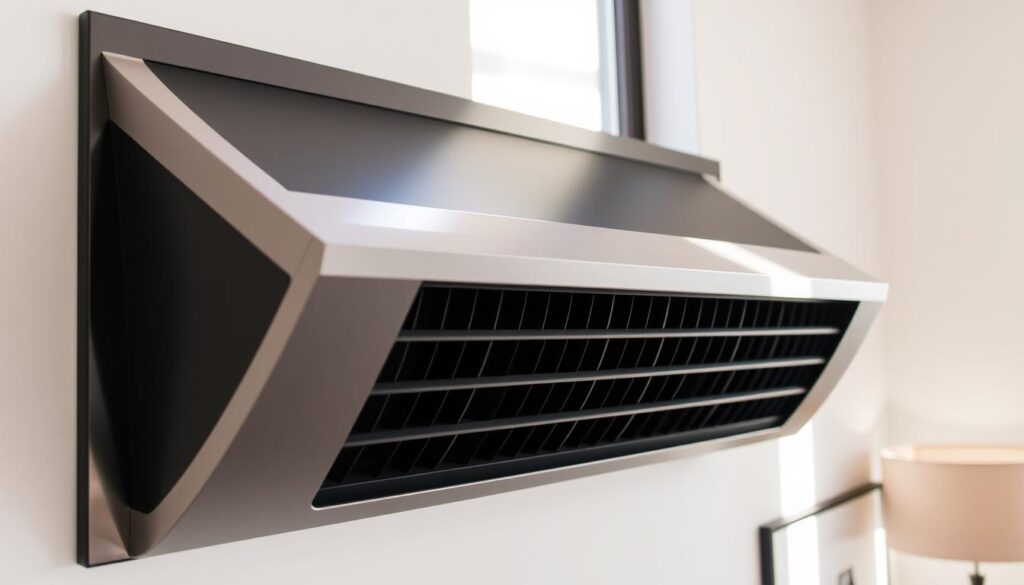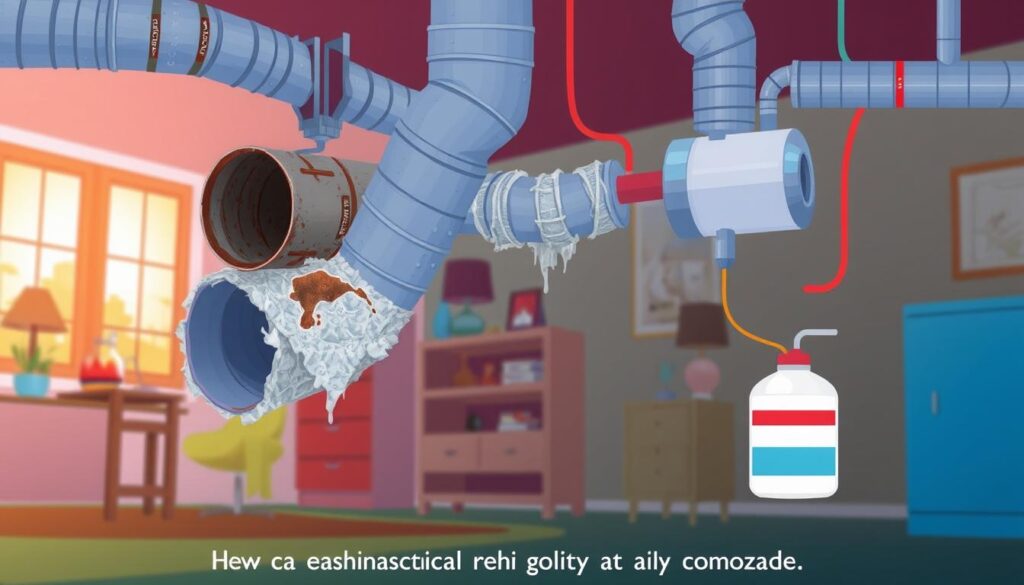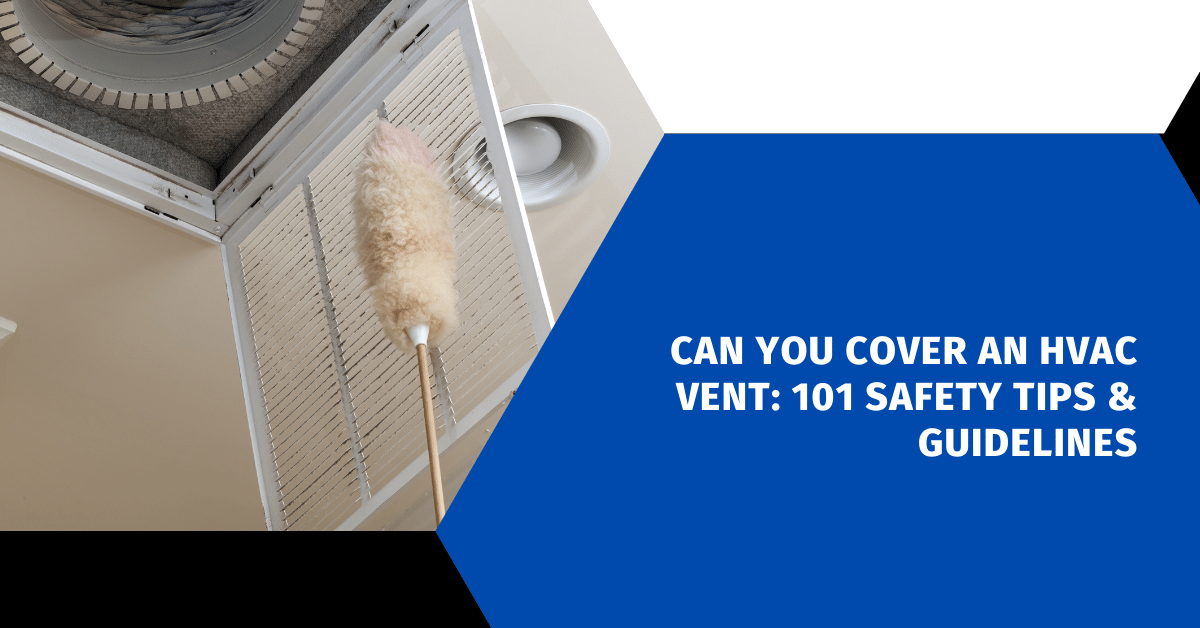Affiliate Disclosure
HVAC Guide Guys is a participant in the Amazon Services LLC Associates Program, an affiliate advertising program designed to provide a means for sites to earn advertising fees by advertising and linking to Amazon.
Can You Cover an HVAC Vent? As a homeowner, you might think about covering an HVAC vent. This is especially true in small spaces like bathrooms or unused rooms. It seems like a simple way to control the temperature and airflow. But, covering HVAC vents can cause problems, from less efficient systems to safety risks.

Sarah, a busy mom of three, noticed her guest bedroom was always too warm. She thought closing the vent would cool it down. But, her HVAC system started acting up, and the air quality worsened. She didn’t know covering the vent was causing big problems.
In this article, we’ll look at the safety issues, system damage, and better ways to manage HVAC vents. You’ll learn how to keep your home comfortable without harming your HVAC system’s health and efficiency.
Key Takeaways
- Covering HVAC vents can lead to various issues, including decreased system efficiency and potential safety risks.
- Proper airflow and ventilation are crucial for your home’s heating and cooling performance.
- Regularly cleaning vent covers and ensuring even air distribution are important maintenance tasks.
- Closing vents completely is not recommended, as it can cause system strain and potential damage.
- Consider professional HVAC modifications or alternative solutions to address temperature control issues.
Table of Contents
Understanding HVAC Vent Systems and Their Purpose
Your home’s HVAC system is like a circulatory system. It spreads conditioned air all over. The supply vents and return vents are key to this process.
How Air Circulation Works in Your Home
Supply vents send heated or cooled air to different rooms. Return vents pull the air back into the system. This keeps the air moving and your home comfortable.
The Role of Supply and Return Vents
- Supply vents send out the conditioned air, while return vents pull it back to the HVAC system.
- A balanced air pressure system is vital for comfort and efficiency.
- Blocking vents can harm your HVAC’s performance and even damage it.
Knowing how your HVAC vent system works is key. It keeps your home comfy, saves energy, and makes your HVAC last longer.
| Component | Function | Lifespan |
|---|---|---|
| Metal air ducts | Distribute conditioned air | Several decades |
| Flexible ducts | Distribute conditioned air | Shorter lifespan |
| Duct seals and connections | Maintain air tight system | Can weaken over time |
Explore Our HVAC Shop
Looking for top-rated HVAC tools, parts, and accessories? Visit our shop and find the perfect solution for your needs.
Visit the ShopCan You Cover an HVAC Vent: The Truth Revealed
It might seem smart to cover your HVAC vents to save energy or control temperature. But, it’s not a good idea. It can cause problems that hurt your heating and cooling system’s performance and efficiency.
Covering vents can mess with airflow. Closing vents in unused rooms can make duct system pressure go up by 20%. This can make your system work harder, leading to higher energy bills and shorter equipment life.
Blocked airflow from covered vents can also cut system efficiency by up to 15%. Up to 30% of conditioned air can leak out through ducts. This is worse when vents are closed, due to pressure changes.
But there’s a bigger risk: safety. Blocked airflow can cause carbon monoxide, mold, and mildew to build up. This can harm your family’s health and air quality inside your home.
Instead of covering vents, there are better ways to control temperature and save energy. You can:
- Seal air leaks with caulk and weather stripping to boost HVAC efficiency
- Get a zoned heating system for temperature control in each room
- Change air filters often to keep airflow and system performance good
- Use air purifiers to clean the air in your home
By knowing the risks and trying other methods, you can keep your HVAC system running well. This ensures a comfortable and healthy home for your family.
Explore Our HVAC Shop
Looking for top-rated HVAC tools, parts, and accessories? Visit our shop and find the perfect solution for your needs.
Visit the ShopCommon Reasons People Consider Covering Vents
Homeowners often think about covering their HVAC vents for different reasons. These include fixing temperature issues, managing unused spaces, or improving looks. But, the benefits of covering vents are often not worth the risks and inefficiencies they can cause.
Temperature Control Issues
One reason people cover vents is to fix temperature problems in their homes. They think closing vents in some rooms will help other areas stay cooler or warmer. But, this can mess up your HVAC system’s balance, leading to uneven temperatures and damage.
Unused Room Management
Another reason is to manage airflow in unused rooms. People believe covering vents in these rooms will improve air flow in used areas. But, this can actually hurt your HVAC system’s performance, causing pressure issues and wasting energy.
Aesthetic Concerns
Some homeowners cover vents to make their homes look better. Vent covers seem like an easy and cheap fix. But, they don’t solve the real HVAC problems like size issues or zoning needs. Long-term, these changes can hurt your system’s efficiency and performance.
Before deciding to cover HVAC vents, think carefully. It can affect your home’s comfort, energy use, and health.
Safety Risks of Covering HVAC Vents
Covering your HVAC vents might seem like an easy fix for temperature or looks. But, it can be very dangerous. It messes with your home’s heating and cooling system, leading to big problems.
One big risk is the pressure it puts on your system. This can damage parts like the heat exchanger. If it breaks, it can leak carbon monoxide, a silent killer.
Also, blocked vents can make your system overheat. This increases the chance of fires. The system works too hard, which can cause it to fail.
- Covering HVAC vents can cause heat exchangers to crack, leading to carbon monoxide leaks.
- Restricted airflow can cause system overheating, raising the risk of fire hazards.
- Blocked vents force the HVAC system to work harder, leading to increased energy consumption and shorter system lifespan.
It’s not worth the risk to cover your HVAC vents. Talk to a professional HVAC technician for safer solutions. Your family’s safety is more important than anything.

“Proper HVAC ventilation is essential for maintaining a safe and healthy indoor environment. Covering vents can have serious consequences that no homeowner should ever have to face.”
Explore Our HVAC Shop
Looking for top-rated HVAC tools, parts, and accessories? Visit our shop and find the perfect solution for your needs.
Visit the ShopImpact on System Performance and Efficiency
Covering your HVAC vents might seem like a simple way to control temperature and save energy. But, it can actually harm your system’s performance and efficiency. It disrupts the delicate pressure balance in your HVAC network, leading to many issues.
Pressure Balance Problems
Closing vents restricts airflow, causing pressure imbalance. This strain on the blower motor increases energy use and can damage it over time. Also, air leaks in the ductwork let conditioned air escape, reducing your HVAC system’s efficiency.
Energy Consumption Effects
Closing vents doesn’t save energy; it can actually increase it. Your HVAC system works best when all vents are open. Closing vents makes it work harder, leading to higher energy use and bills.
System Strain and Wear
Closed vents put extra strain on your HVAC system. This can wear down components like the blower motor and compressor. It shortens your system’s life and may cause more repairs.
To keep your HVAC system running well, it’s key to keep all vents open. This lets your system work as it should, maintaining a stable pressure balance. It ensures consistent, energy-efficient cooling or heating in your home.
Potential Damage to Your HVAC System
Covering your HVAC vents can cause serious damage to your home’s heating, ventilation, and air conditioning (HVAC) system. This simple action can lead to big problems, affecting your system’s efficiency and lifespan.
One major risk is increased pressure in the ductwork. When vents are covered, the system has to work harder. This can lead to duct leaks and compressor failures. These issues can be expensive and shorten your system’s life.
Another issue is frozen evaporator coils. Without enough air, the coils can freeze. This causes damage and may require costly replacements.

Statistics show that over 60% of HVAC system damages come from dust and debris. Cleaning air filters during remodels can help. Professional duct cleaning can also improve efficiency by up to 25%.
To prevent these damages, work with professional HVAC technicians. They can help manage vents and maintain your system during renovations. Taking these steps can protect your investment and keep your HVAC system running well for years.
Explore Our HVAC Shop
Looking for top-rated HVAC tools, parts, and accessories? Visit our shop and find the perfect solution for your needs.
Visit the ShopHealth and Environmental Concerns
Covering your HVAC vents can create a perfect spot for mold and mildew to grow. When air can’t move freely, moisture gets trapped in the ducts. This creates a perfect place for mold and mildew to thrive.
This can really hurt the air quality in your home. It poses big health risks to you and your family.
Mold and Mildew Growth
Mold and mildew in your HVAC system is a big problem. Experts say that if your home’s humidity is over 65%, mold will likely grow. The average cost of air duct and vent cleaning in the US is about $327 a year. It’s best to clean them once a year to stop mold and mildew.
Air Quality Issues
Covering your HVAC vents can also cut down on air flow. This can make the air in your home worse. Neglected HVAC systems can make indoor air quality bad, making breathing problems like asthma worse. It can also spread dust mites, pet dander, pollen, and mold spores.
This can make allergies worse, causing sneezing and coughing. It’s important to keep air flowing well to keep your home healthy. Covering your HVAC vents can harm your air quality, mold growth, and HVAC health risks. You should fix any HVAC problems quickly to keep your family safe.
Alternative Solutions for Temperature Control
Instead of covering your HVAC vents, look into other ways to control temperature. These include HVAC zoning, smart thermostats, and professional system balancing. They can help without hurting your home’s heating and cooling system.
HVAC Zoning Systems
HVAC zoning lets you control different areas of your home. You can set temperatures for each room or area. This way, you can fix hot or cold spots and get even temperatures everywhere.
Smart Thermostats
Smart thermostats like Ecobee, Google Nest, and Honeywell Home are advanced. They learn your temperature likes and adjust automatically. They cost about $200 and up, with sensors around $40 each.
Professional System Balancing
For uneven temperatures, get a pro to balance your HVAC system. They’ll adjust airflow and pressure in your ducts. This ensures each room gets the right air without blocking vents.
These alternatives can improve your temperature control without hurting your HVAC system. Try HVAC zoning, smart thermostats, and professional balancing for a more comfy and energy-saving home.
| Solution | Average Cost | Key Features |
|---|---|---|
| HVAC Zoning | $80 – $130 per vent cover, $30 – $130 per temperature sensor | Divides home into separate climate-controlled zones, allows customized temperature settings |
| Smart Thermostats | $200 and up, $40 per additional sensor | Learns temperature preferences, automatically adjusts settings for energy efficiency |
| Professional System Balancing | Varies based on HVAC system and home size | Adjusts airflow and pressure within ductwork for optimal temperature distribution |
“Adjusting supply vents strategically during peak heating and cooling seasons can impact the effectiveness and comfort of the HVAC system.”
Exploring these alternatives can help you find the best way to control temperature. This way, you can keep your HVAC system safe and efficient.
Explore Our HVAC Shop
Looking for top-rated HVAC tools, parts, and accessories? Visit our shop and find the perfect solution for your needs.
Visit the ShopProfessional HVAC Modifications and Options
Dealing with HVAC issues like temperature control or aesthetic concerns? It’s best to talk to a pro. They can tailor solutions to boost your system’s performance and efficiency. This ensures your home stays comfortable and the air quality is top-notch.
Proper Vent Adjustment Methods
A skilled HVAC technician can tweak your vents for better airflow. They might move vents, change vent openings, or even move vent locations. This ensures air reaches every corner of your home effectively.
System Balancing Solutions
HVAC experts can balance your system too. They adjust ductwork, airflow, and more to get everything working together. This fixes issues like uneven cooling or heating and boosts your system’s efficiency.
Having HVAC problems or planning home changes? Always get a pro’s advice. They offer the right HVAC modifications, professional vent adjustment, and system balancing to keep your home comfy and energy-smart.
“Regular maintenance and proper adjustments by a professional can significantly improve the performance and lifespan of your HVAC system.”
Proper Maintenance Tips for HVAC Vents
Keeping your HVAC system and vents in good shape is key for the best performance and air quality. A few easy steps can make sure your home’s air flows well and efficiently.
Keep Vents Clean and Unobstructed
Cleaning your vents regularly is vital for good airflow. Dust, pet hair, and other particles can build up and block air. Use a vacuum or a damp cloth to clean your vents every few months.
Replace Air Filters Regularly
Changing your HVAC’s air filters is a crucial task. Dirty filters can slow down airflow, making your system work harder and use more energy. It’s best to replace filters every month for the best results.
Schedule Professional HVAC Maintenance
While you can do some maintenance yourself, getting a pro to check your system is important. A skilled technician can inspect your system, clean the ducts, and make any needed adjustments. This ensures your system runs efficiently and your air is clean.
| Maintenance Task | Frequency |
|---|---|
| Vent Cleaning | Every 3-4 months |
| Air Filter Replacement | Monthly |
| Professional HVAC Inspection | Annually |
By following these HVAC maintenance tips, you can keep your vents and system in great condition. This improves your indoor air quality and helps you avoid the need to cover your vents.
Conclusion
Covering HVAC vents might seem like a simple way to control temperature. But, it’s not safe and can harm your system. It can cause ductwork pressure, mold, and even fire hazards.
Instead, talk to HVAC experts for safer, better solutions. They can help keep your system working well and your home comfortable. Regular maintenance, like cleaning vents and ducts, also improves air quality and your equipment’s life.
For HVAC vent safety, system efficiency, and the best fixes, trust professional HVAC consultations. Working with skilled technicians ensures your home is safe and energy-efficient. This way, you can fix temperature issues without risking your family’s health.

